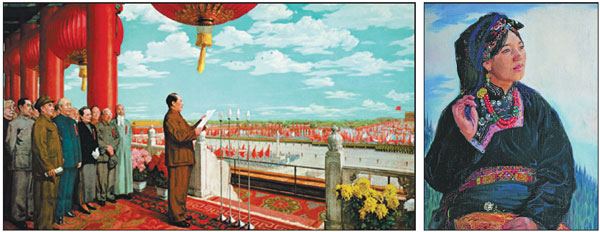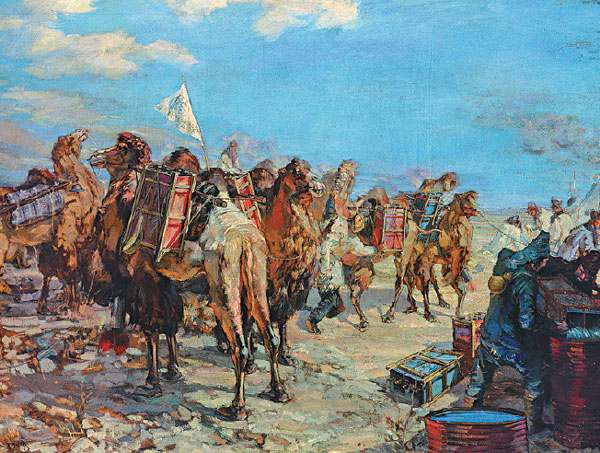Love of art
Updated: 2014-12-30 07:13
By Deng Zhangyu(China Daily)
|
|||||||||||
The original draft for New China's founding ceremony is unveiled in a major retrospective of painter Dong Xiwen's pieces. Deng Zhangyu reports.
The Founding Ceremony of China has been considered among the country's key historical artworks since it was painted by late artist Dong Xiwen in 1952.
But it wasn't widely known that alterations to the final piece - reflective of political changes in China in the past few decades - had been made, until the original draft was recently unveiled in public for the first time.
|
Left: Founding Ceremony of China, oil on canvas, by Dong Xiwen, 1952. Right: Tibetan Woman, oil on woodblock, by Dong Xiwen, 1955. Photos Provided to China Daily |
|
Xinjiang Transport Corps, oil on canvas, by Dong Xiwen, 1944. |
A major retrospective of Dong's works to mark the 100th anniversary of the artist's birth opened at the Art Museum of the Central Academy of Fine Arts in Beijing on Dec 19 - more than half a century after the draft of Founding Ceremony of China was thought to have gone missing.
According to the artist's daughter, Dong Yisha, the draft had remained in their family home in Beijing for all these years, awaiting an "appropriate opportunity" for a public showing. The oil painting has since stayed with the National Museum of China.
The Founding Ceremony of China portrays chairman Mao announcing the birth of New China from the rostrum at Tian'anmen Square in 1949.
Mao is said to have seen the original piece and praised it for projecting China's rise.
But three political figures standing behind Mao in the 1952 painting were changed in subsequent years.
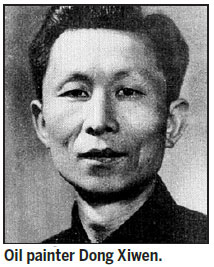
In 1955, the National Museum of China asked Dong to delete then vice-president Gao Gang from the painting, in which he was shown standing in the first row behind Mao. Dong Xiwen used a flower pot to replace Gao, who had been expelled from the Communist Party of China the year before.
In 1971, Dong was asked by the same museum to remove Liu Shaoqi, a former vice-president who was reviled by a section of the Party during the "cultural revolution" (1966-76), from the piece. At the time, the artist replaced Liu with Dong Biwu, another founding father of the CPC.
The following year, Dong was instructed to remove Lin Boqu from the painting. Lin was then general-secretary of the Central People's Government Committee and had a falling out with the leadership. But by then, the painter was taken ill by stomach cancer. He, in turn, asked Jin Shangyi, one of his students, to reproduce the painting without Lin in it.
Finally, the oil painting was restored to its original look in 1979, with the three political figures back in place. This version, which is the collective work of several artists, including Jin, is now most often viewed by the public.
"The changes to the painting tell a bitter story, reflecting the political influences on art. But it didn't affect Dong Xiwen's love of art, " Fan Di'an, curator of the retrospective, told reporters at the show's opening.
While the Founding Ceremony of China as an artwork has always been famous, the public has known little about the artist. The retrospective of his 128 paintings gives people a chance to understand Dong Xiwen better.
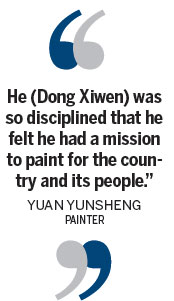
He was born in a family that owned a large number of Chinese paintings, ceramics and works of calligraphy. Dong Xiwen's interest in art developed in his childhood, leading him to visit many top art colleges in different countries to learn from master painters.
In the 1940s, the artist and his wife went to Dunhuang in Northwest China's Gansu province, which is famous for its Buddhist grottoes. The couple lived in a house that had been a cowshed.
Despite their modest means, his passion for art remained intact, says his son Dong Shalei. While in Dunhuang, Dong Xiwen made paintings of the Buddhist murals, which helped him develop a new Chinese style on canvas.
Dong Xiwen was 38 when he was assigned to draw the most significant historical image of China's founding in 1952.
After that, he worked on many other paintings of historical events, such as the Long March of the Red Army (October 1934-October 1935), the War of Liberation (1946-49) and the Korean War (1950-53).
From 1954, he traveled a few times to the Tibet autonomous region, where he captured people's lives and the landscape in oil. In his last days, he often talked of his travels through the region, saying "the river there was so quiet that even the sound of a stone throw into it could be heard", his son says.
He died in 1973.
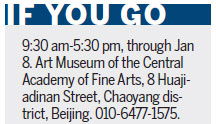
The retrospective show, on through Jan 8, exhibits many drafts of Dong's large-scale paintings for the first time. It's also the first time that his works collected by different Chinese museums are being displayed together.
Art critic Wan Shaojun says that it isn't fair to the artist that people see his paintings more from a political view rather than for art itself.
"He was so disciplined that he felt he had a mission to paint for the country and its people. Even when he was ill, he was still passionate about art for the people," says Yuan Yunsheng, a famous painter, who learned from the master.
Contact the writer at dengzhangyu@chinadaily.com.cn
(China Daily 12/30/2014 page19)
Today's Top News
Missing AirAsia plane maybe 'at sea bottom'
More than 200 evacuated from buring Italian ferry
Aviation's deadly 2014, yet safety record improving
Albania takes part in rescue efforts on burning Italian-flagged ferry
Debate on largest economy pointless
China to ease investment rules in FTZ
China to add over 13 million jobs in 2014
Beijing eyes 5% drop in PM2.5
Hot Topics
Lunar probe , China growth forecasts, Emission rules get tougher, China seen through 'colored lens', International board,
Editor's Picks

|

|

|

|

|
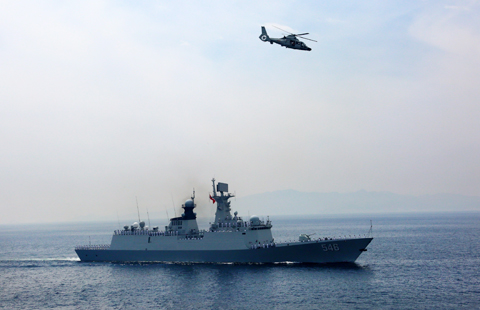
|
